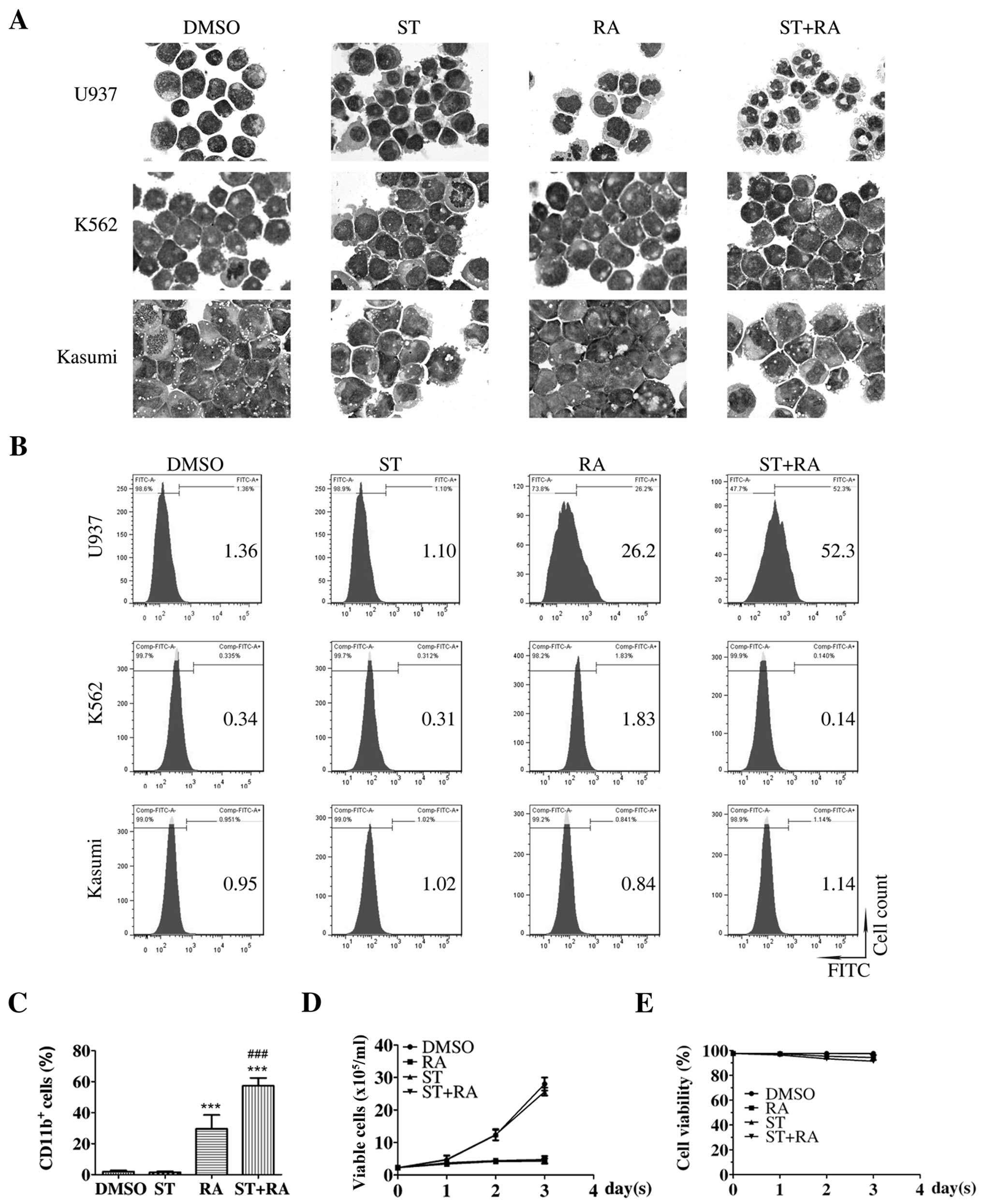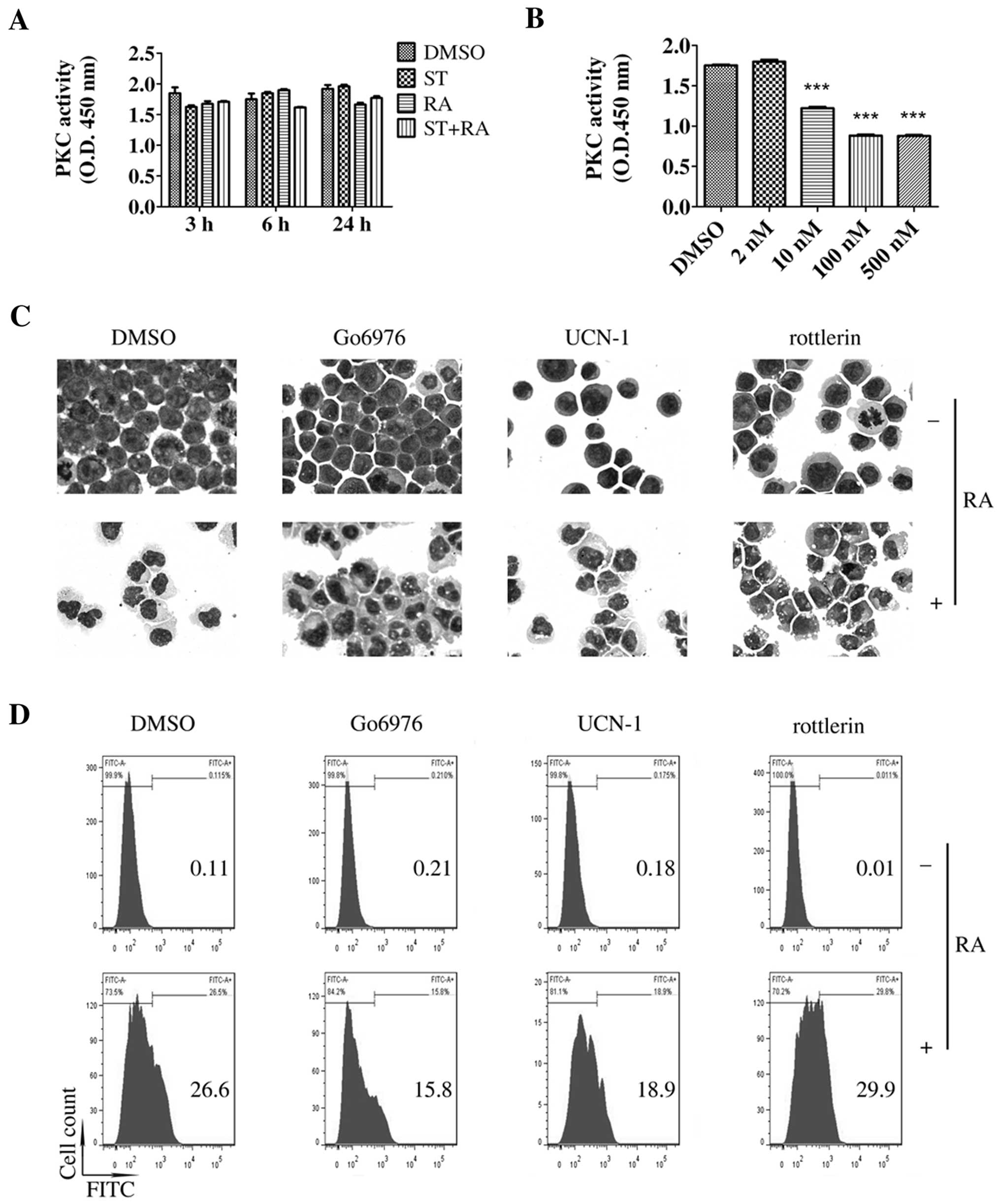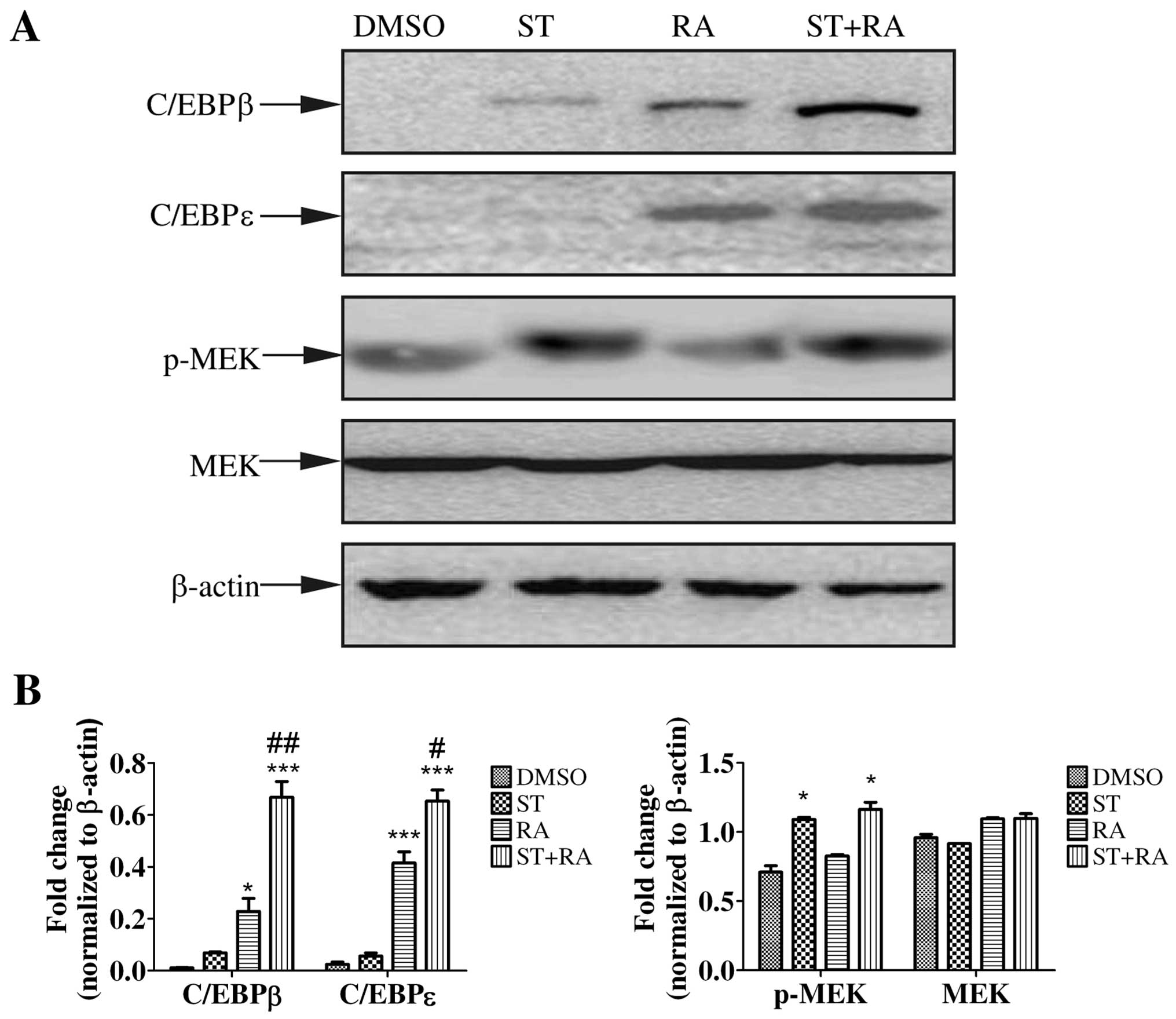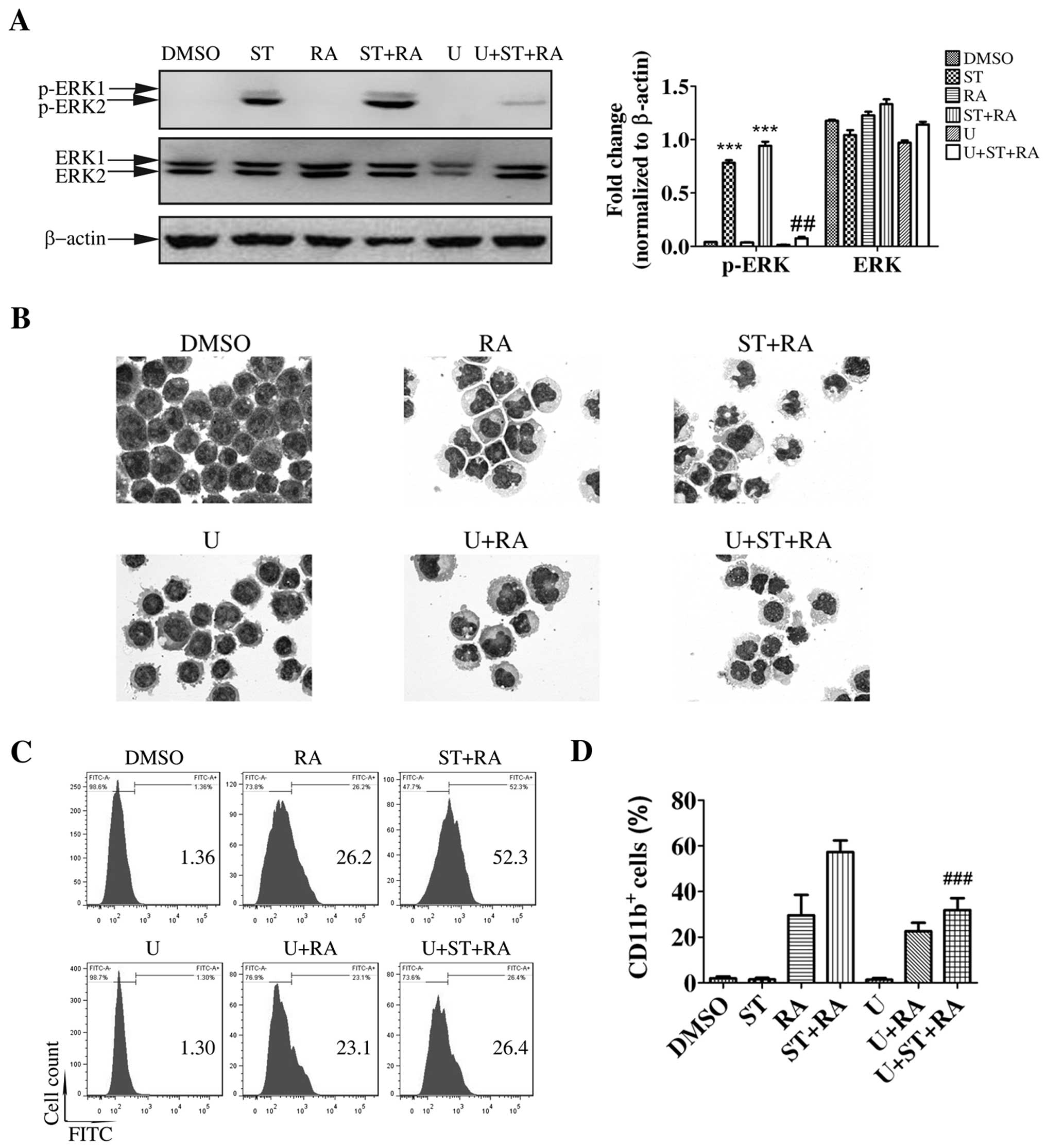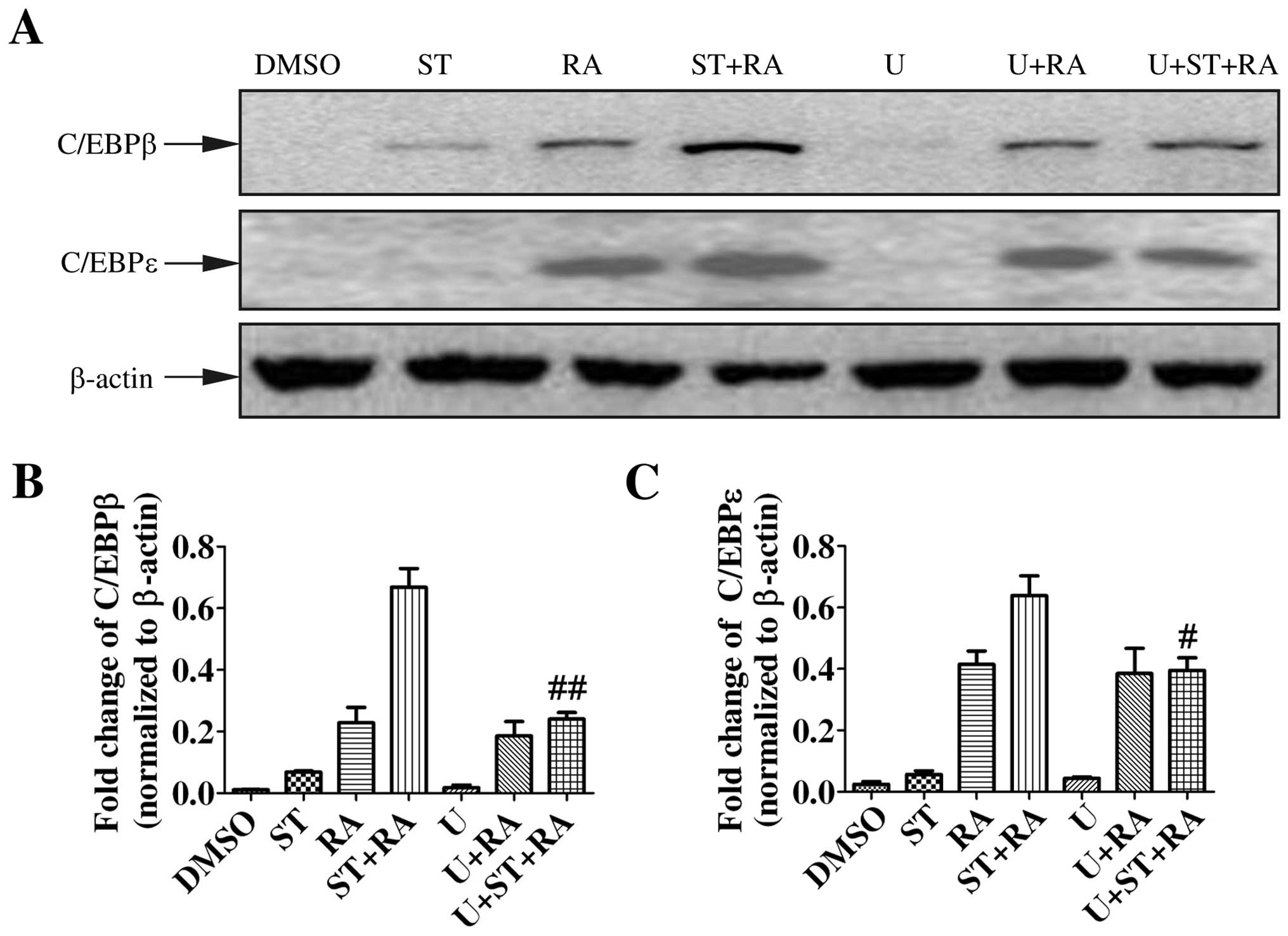|
1
|
Wang ES: Treating acute myeloid leukemia
in older adults. Hematology Am Soc Hematol Educ Program.
2014:14–20. 2014.
|
|
2
|
Ablain J and de Thé H: Retinoic acid
signaling in cancer: The parable of acute promyelocytic leukemia.
Int J Cancer. 135:2262–2272. 2014. View Article : Google Scholar : PubMed/NCBI
|
|
3
|
Göttlicher M, Minucci S, Zhu P, Krämer OH,
Schimpf A, Giavara S, Sleeman JP, Lo Coco F, Nervi C, Pelicci PG,
et al: Valproic acid defines a novel class of HDAC inhibitors
inducing differentiation of transformed cells. EMBO J.
20:6969–6978. 2001. View Article : Google Scholar : PubMed/NCBI
|
|
4
|
Tassara M, Döhner K, Brossart P, Held G,
Götze K, Horst HA, Ringhoffer M, Köhne CH, Kremers S, Raghavachar
A, et al: Valproic acid in combination with all-trans retinoic acid
and intensive therapy for acute myeloid leukemia in older patients.
Blood. 123:4027–4036. 2014. View Article : Google Scholar : PubMed/NCBI
|
|
5
|
Bug G, Ritter M, Wassmann B, Schoch C,
Heinzel T, Schwarz K, Romanski A, Kramer OH, Kampfmann M, Hoelzer
D, et al: Clinical trial of valproic acid and all-trans retinoic
acid in patients with poor-risk acute myeloid leukemia. Cancer.
104:2717–2725. 2005. View Article : Google Scholar : PubMed/NCBI
|
|
6
|
Kuendgen A, Schmid M, Schlenk R, Knipp S,
Hildebrandt B, Steidl C, Germing U, Haas R, Dohner H and Gattermann
N: The histone deacetylase (HDAC) inhibitor valproic acid as
monotherapy or in combination with all-trans retinoic acid in
patients with acute myeloid leukemia. Cancer. 106:112–119. 2006.
View Article : Google Scholar
|
|
7
|
Schenk T, Chen WC, Göllner S, Howell L,
Jin L, Hebestreit K, Klein HU, Popescu AC, Burnett A, Mills K, et
al: Inhibition of the LSD1 (KDM1A) demethylase reactivates the
all-trans-retinoic acid differentiation pathway in acute myeloid
leukemia. Nat Med. 18:605–611. 2012. View
Article : Google Scholar : PubMed/NCBI
|
|
8
|
Ying M, Zhou X, Zhong L, Lin N, Jing H,
Luo P, Yang X, Song H, Yang B and He Q: Bortezomib sensitizes human
acute myeloid leukemia cells to all-trans-retinoic acid-induced
differentiation by modifying the RARα/STAT1 axis. Mol Cancer Ther.
12:195–206. 2013. View Article : Google Scholar
|
|
9
|
Gianni' M, Boldetti A, Guarnaccia V,
Rambaldi A, Parrella E, Raska I Jr, Rochette-Egly C, Del Sal G,
Rustighi A, Terao M, et al: Inhibition of the
peptidyl-prolyl-isomerase Pin1 enhances the responses of acute
myeloid leukemia cells to retinoic acid via stabilization of
RARalpha and PML-RARalpha. Cancer Res. 69:1016–1026. 2009.
View Article : Google Scholar : PubMed/NCBI
|
|
10
|
Omura S, Sasaki Y, Iwai Y and Takeshima H:
Staurosporine, a potentially important gift from a microorganism. J
Antibiot (Tokyo). 48:535–548. 1995. View Article : Google Scholar
|
|
11
|
Yoo CB, Yun SM, Jo C and Koh YH:
γ-Secretase-dependent cleavage of E-cadherin by staurosporine in
breast cancer cells. Cell Commun Adhes. 19:11–16. 2012. View Article : Google Scholar : PubMed/NCBI
|
|
12
|
Mollereau C, Zajac JM and Roumy M:
Staurosporine differentiation of NPFF2
receptor-transfected SH-SY5Y neuroblastoma cells induces
selectivity of NPFF activity towards opioid receptors. Peptides.
28:1125–1128. 2007. View Article : Google Scholar : PubMed/NCBI
|
|
13
|
Zhao C, Yin P, Mei C, Li N, Yao W, Li X,
Qi J, Fan K, Li Z, Wang L, et al: Down-regulation of DNA
methyltransferase 3B in staurosporine-induced apoptosis and its
mechanism in human hepatocarcinoma cell lines. Mol Cell Biochem.
376:111–119. 2013. View Article : Google Scholar : PubMed/NCBI
|
|
14
|
Shimizu T, Okayama A, Inoue T and Takeda
K: Analysis of gene expression during staurosporine-induced
neuronal differentiation of human prostate cancer cells. Oncol Rep.
14:441–448. 2005.PubMed/NCBI
|
|
15
|
Okazaki T, Kato Y, Mochizuki T, Tashima M,
Sawada H and Uchino H: Staurosporine, a novel protein kinase
inhibitor, enhances HL-60-cell differentiation induced by various
compounds. Exp Hematol. 16:42–48. 1988.PubMed/NCBI
|
|
16
|
Ge DZ, Sheng Y and Cai X: Combined
staurosporine and retinoic acid induces differentiation in retinoic
acid resistant acute promyelocytic leukemia cell lines. Sci Rep.
4:48212014. View Article : Google Scholar : PubMed/NCBI
|
|
17
|
Kiley SC and Parker PJ: Differential
localization of protein kinase C isozymes in U937 cells: Evidence
for distinct isozyme functions during monocyte differentiation. J
Cell Sci. 108:1003–1016. 1995.PubMed/NCBI
|
|
18
|
Scott LM, Civin CI, Rorth P and Friedman
AD: A novel temporal expression pattern of three C/EBP family
members in differentiating myelomonocytic cells. Blood.
80:1725–1735. 1992.PubMed/NCBI
|
|
19
|
Lekstrom-Himes JA: The role of
C/EBP(epsilon) in the terminal stages of granulocyte
differentiation. Stem Cells. 19:125–133. 2001. View Article : Google Scholar : PubMed/NCBI
|
|
20
|
Duprez E, Wagner K, Koch H and Tenen DG:
C/EBPbeta: A major PML-RARA-responsive gene in retinoic
acid-induced differentiation of APL cells. EMBO J. 22:5806–5816.
2003. View Article : Google Scholar : PubMed/NCBI
|
|
21
|
Truong BT, Lee YJ, Lodie TA, Park DJ,
Perrotti D, Watanabe N, Koeffler HP, Nakajima H, Tenen DG and Kogan
SC: CCAAT/Enhancer binding proteins repress the leukemic phenotype
of acute myeloid leukemia. Blood. 101:1141–1148. 2003. View Article : Google Scholar
|
|
22
|
Miranda MB, McGuire TF and Johnson DE:
Importance of MEK-1/-2 signaling in monocytic and granulocytic
differentiation of myeloid cell lines. Leukemia. 16:683–692. 2002.
View Article : Google Scholar : PubMed/NCBI
|
|
23
|
Gobert Gosse S, Bourgin C, Liu WQ, Garbay
C and Mouchiroud G: M-CSF stimulated differentiation requires
persistent MEK activity and MAPK phosphorylation independent of
Grb2-Sos association and phosphatidylinositol 3-kinase activity.
Cell Signal. 17:1352–1362. 2005. View Article : Google Scholar : PubMed/NCBI
|
|
24
|
Miranda MB, Xu H, Torchia JA and Johnson
DE: Cytokine-induced myeloid differentiation is dependent on
activation of the MEK/ERK pathway. Leuk Res. 29:1293–1306. 2005.
View Article : Google Scholar : PubMed/NCBI
|
|
25
|
Barbarroja N, Siendones E, Torres LA,
Luque MJ, Martinez JM, Dorado G, Velasco F, Torres A and
López-Pedrera C: MEK inhibition induces caspases activation,
differentiation blockade and PML/RARalpha degradation in acute
promyelocytic leukaemia. Br J Haematol. 142:27–35. 2008. View Article : Google Scholar : PubMed/NCBI
|
|
26
|
Milella M, Konopleva M, Precupanu CM, Tabe
Y, Ricciardi MR, Gregorj C, Collins SJ, Carter BZ, D'Angelo C,
Petrucci MT, et al: MEK blockade converts AML differentiating
response to retinoids into extensive apoptosis. Blood.
109:2121–2129. 2007. View Article : Google Scholar
|
|
27
|
Dunai ZA, Imre G, Barna G, Korcsmaros T,
Petak I, Bauer PI and Mihalik R: Staurosporine induces necroptotic
cell death under caspase-compromised conditions in U937 cells. PLoS
One. 7:e419452012. View Article : Google Scholar : PubMed/NCBI
|
|
28
|
Cho JY, Katz DR and Chain BM:
Staurosporine induces rapid homotypic intercellular adhesion of
U937 cells via multiple kinase activation. Br J Pharmacol.
140:269–276. 2003. View Article : Google Scholar : PubMed/NCBI
|
|
29
|
Devalia V, Thomas NS, Roberts PJ, Jones HM
and Linch DC: Down-regulation of human protein kinase C alpha is
associated with terminal neutrophil differentiation. Blood.
80:68–76. 1992.PubMed/NCBI
|
|
30
|
McNamara S, Nichol JN, Wang H and Miller
WH Jr: Targeting PKC delta-mediated topoisomerase II beta
overexpression subverts the differentiation block in a retinoic
acid-resistant APL cell line. Leukemia. 24:729–739. 2010.
View Article : Google Scholar : PubMed/NCBI
|
|
31
|
Ko JH, Park WS and Earm YE: The protein
kinase inhibitor, staurosporine, inhibits L-type Ca2+
current in rabbit atrial myocytes. Biochem Biophys Res Commun.
329:531–537. 2005. View Article : Google Scholar : PubMed/NCBI
|
|
32
|
Park WS, Son YK, Han J, Kim N, Ko JH, Bae
YM and Earm YE: Staurosporine inhibits voltage-dependent
K+ current through a PKC-independent mechanism in
isolated coronary arterial smooth muscle cells. J Cardiovasc
Pharmacol. 45:260–269. 2005. View Article : Google Scholar : PubMed/NCBI
|
|
33
|
Yagi Y, Sotani T, Nagao T, Horio T,
Yamamoto I and Gohda E: Induction by staurosporine of hepatocyte
growth factor production in human skin fibroblasts independent of
protein kinase inhibition. Biochem Pharmacol. 66:1797–1808. 2003.
View Article : Google Scholar : PubMed/NCBI
|
|
34
|
Tabakman R, Lazarovici P, Matsuda Y,
Brodie C and Ovadia H: Protein kinase C-independent selective
induction of nitric oxide synthase activity in rat alveolar
macrophages by staurosporine. Nitric Oxide. 2:250–258. 1998.
View Article : Google Scholar : PubMed/NCBI
|
|
35
|
Sowa G and Przewłocki R: Enhancing effect
of staurosporine on NO production in rat peritoneal macrophages via
a protein kinase C-independent mechanism. Br J Pharmacol.
116:1711–1712. 1995. View Article : Google Scholar : PubMed/NCBI
|
|
36
|
Davis RJ: Transcriptional regulation by
MAP kinases. Mol Reprod Dev. 42:459–467. 1995. View Article : Google Scholar : PubMed/NCBI
|
|
37
|
Lu J, Wu DM, Zheng YL, Hu B, Cheng W,
Zhang ZF and Li MQ: Troxerutin counteracts domoic acid-induced
memory deficits in mice by inhibiting CCAAT/enhancer binding
protein β-mediated inflammatory response and oxidative stress. J
Immunol. 190:3466–3479. 2013. View Article : Google Scholar : PubMed/NCBI
|
|
38
|
Alam M, Ahmad R, Rajabi H, Kharbanda A and
Kufe D: MUC1-C oncoprotein activates ERK→C/EBPβ signaling and
induction of aldehyde dehydrogenase 1A1 in breast cancer cells. J
Biol Chem. 288:30892–30903. 2013. View Article : Google Scholar : PubMed/NCBI
|
|
39
|
Piwien Pilipuk G, Galigniana MD and
Schwartz J: Subnuclear localization of C/EBP beta is regulated by
growth hormone and dependent on MAPK. J Biol Chem. 278:35668–35677.
2003. View Article : Google Scholar : PubMed/NCBI
|
|
40
|
Park BH, Qiang L and Farmer SR:
Phosphorylation of C/EBPbeta at a consensus extracellular
signal-regulated kinase/glycogen synthase kinase 3 site is required
for the induction of adiponectin gene expression during the
differentiation of mouse fibroblasts into adipocytes. Mol Cell
Biol. 24:8671–8680. 2004. View Article : Google Scholar : PubMed/NCBI
|



